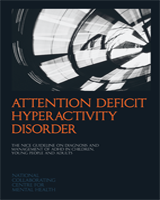| Total number of studies (number of participants) | 6 (462) |
| Study ID | BROWN1985
FIRESTONE1981
FIRESTONE1986
GITTELMAN-KLEIN1976
KLEIN1997
MTA1999 |
| Age | 5–12 years |
| Benefits (end of treatment) |
| Core ADHD symptoms at end of treatment (teacher-rated) | SMD −0.72 (−1.12 to −0.32)
Quality: High
K = 5, N = 392 |
| Core ADHD symptoms at end of treatment (parent-rated) | SMD −0.45 (−0.66 to −0.23)
Quality: High
K = 4, N = 350 |
| Conduct at end of treatment (teacher-rated) | SMD −0.48 (−0.70 to −0.25)
Quality: High
K = 3, N = 321 |
| Conduct at end of treatment (parent-rated) | SMD −0.22 (−0.43 to −0.01)
Quality: High
K = 3, N = 355 |
| Social skills at end of treatment (teacher-rated) | SMD −0.33 (−0.57 to −0.08)
Quality: High
K = 2, N = 258 |
| Social skills at end of treatment (parent-rated) | SMD −0.08 (−0.33 to 0.17)
Quality: High
K = 1, N = 151 |
| Emotional outcomes at end of treatment (teacher-rated) | SMD 0.14 (−0.10 to 0.39)
Quality: High
K = 2, N = 158 |
| Emotional outcomes end of treatment (parent-rated) | SMD −0.23 (−0.45 to −0.01)
Quality: High
K = 3, N = 331 |
| Benefits (3–6 months post treatment) |
| Core ADHD symptoms at 3 months post-treatment (teacher-rated) | SMD −0.20 (−1.08 to 0.68)
Quality: Moderate
K = 1, N = 20 |
| Core ADHD symptoms at 3 months post-treatment (parent-rated) | SMD −0.82 (−1.74 to 0.11)
Quality: Moderate
K = 1, N = 20 |
| Benefits (7–12 months post-treatment) |
| Core ADHD symptoms at 7–9 months post-treatment (teacher-rated) | SMD −0.53 (−1.23 to 0.17)
Quality: Moderate
K = 1, N = 35 |
| Core ADHD symptoms at 10 months post-treatment (parent- and teacher-rated composite score) | SMD −0.25 (−0.49 to −0.01)
Quality: High
K = 1, N = 267 |
| Conduct at 7–9 months post- treatment (parent-rated) | SMD −0.32 (−1.02 to 0.38)
Quality: Moderate
K = 1, N = 34 |
| Conduct at 10 months post- treatment (parent- and teacher-rated composite score) | SMD −0.10 (−0.34 to 0.14)
Quality: High
K = 1, N = 267 |
| Social skills at 10 months post- treatment (parent- and teacher-rated composite score) | SMD −0.07 (−0.31 to 0.17)
Quality: High
K = 1, N = 267 |
| Benefits (13–24 months post-treatment) |
| Core ADHD symptoms at 19–21 months post-treatment (teacher-rated) | SMD 0.00 (−0.88 to 0.88)
Quality: Moderate
K = 1, N = 20 |
| Core ADHD symptoms at 19–21 months post-treatment (parent-rated) | SMD 0.58 (−0.32 to 1.48)
Quality: Moderate
K = 1, N = 20 |
| Core ADHD symptoms at 13–24 months post-treatment (parent- and teacher-rated composite score) | SMD −0.06 (−0.21 to 0.09)
Quality: High
K = 1, N = 242 |
| Conduct at 22 months post- treatment (parent- and teacher-rated composite score) | SMD 0.00 (−0.25 to 0.25)
Quality: High
K = 1, N = 243 |
| Social skills at 22 months post- treatment (parent- and teacher-rated composite score) | SMD −0.04 (−0.29 to 0.21)
Quality: High
K = 1, N = 243 |
| Education outcomes at end of treatment |
| Reading at end of treatment | SMD −0.10 (−0.30 to 0.09)
Quality: High
K = 5, N = 397 |
| Mathematics at end of treatment | SMD 0.01 (−0.20 to 0.22)
Quality: High
K = 4, N = 358 |
| Education outcomes at 3–6 months post-treatment |
| Reading at 3 months post-treatment | SMD 0.11 (−0.77 to 0.99)
Quality: Moderate
K = 1, N = 20 |
| Mathematics at 3 months post-treatment | SMD 0.57 (−0.32 to 1.47)
Quality: Moderate
K = 1, N = 20 |
| Education outcomes at 7–12 months post-treatment |
| Reading at 7–10 months post-treatment | SMD −0.05 (−0.27 to 0.18)
Quality: High
K = 2, N = 301 |
| Education outcomes at 13–24 months post-treatment |
| Reading 19–22 months post-treatment | SMD 0.03 (−0.22 to 0.27)
Quality: High
K = 2, N = 260 |
| Dichotomous outcomes |
| Leaving study for any reason | Data not pooled
BROWN1985: 0% (medication) versus 0% (psychological)
FIRESTONE1986: 0% versus 0%
MTA1999: 6% versus 2% |
| Non-responders at end of treatment | RR 0.61 (0.50 to 0.76)
Quality: High
K = 4, N = 366 |
| Non-responders at 10 months post-treatment | RR 0.91 (0.77 to 1.07)
Quality: High
K = 4, N = 288 |
